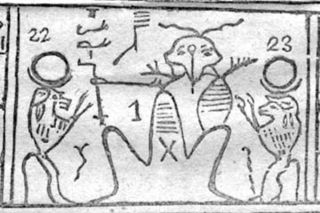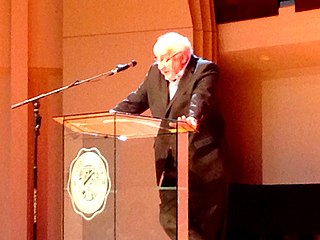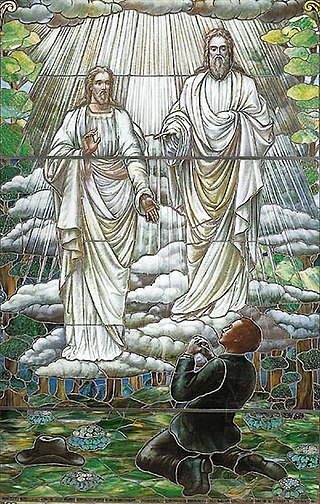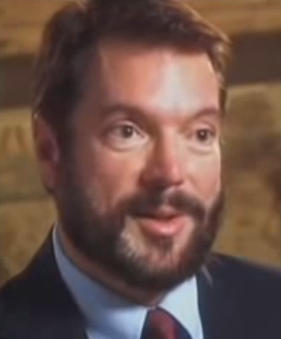Related Research Articles

The Book of Abraham is a collection of writings from several Egyptian scrolls discovered in the early 19th century during an archeological expedition by Antonio Lebolo. Members of the Church of Jesus Christ of Latter-day Saints purchased the scrolls from a traveling mummy exhibition on July 3, 1835, to be translated into English by Joseph Smith. According to Smith, the book was "a translation of some ancient records... purporting to be the writings of Abraham, while he was in Egypt, called the Book of Abraham, written by his own hand, upon papyrus". Smith said the papyri described Abraham's early life, his travels to Canaan and Egypt, and his vision of the cosmos and its creation.

The Latter Day Saint movement is the collection of independent church groups that trace their origins to a Christian Restorationist movement founded by Joseph Smith in the late 1820s.
Jerald Dee Tanner and Sandra McGee Tanner are American writers and researchers who publish archival and evidential materials about the history of the Church of Jesus Christ of Latter-day Saints. The Tanners founded the Utah Lighthouse Ministry (UTLM), whose stated mission is "to document problems with the claims of Mormonism and compare LDS doctrines with Christianity". As of 2022 Sandra Tanner continues to operate the ministry after Jerald's death in 2006.

Hugh Winder Nibley was an American scholar and member of the Church of Jesus Christ of Latter-day Saints who was a professor at Brigham Young University (BYU) for nearly 50 years. He was a prolific author, and wrote apologetic works supporting the archaeological, linguistic, and historical claims of Joseph Smith. He was a member of the LDS Church, and wrote and lectured on LDS scripture and doctrinal topics, publishing many articles in the LDS Church magazines.

Kolob is a star or planet described in the Book of Abraham, a sacred text of the Latter Day Saint movement. Several Latter Day Saint denominations hold the Book of Abraham to have been translated from an Egyptian papyrus scroll by Joseph Smith, the founder of the movement. According to this work, Kolob is the heavenly body nearest to the throne of God. While the Book of Abraham calls Kolob a "star", it also calls planets "stars", and therefore some Latter Day Saint commentators consider Kolob a planet. The body also appears in Latter Day Saint culture, including a reference to Kolob in an LDS hymn.

Richard John Mouw is an American theologian and philosopher. He held the position of President at Fuller Theological Seminary for 20 years (1993–2013), and continues to hold the post of Professor of Faith and Public Life.

Anti-Mormonism is often used to describe people or literature that are critical of their adherents, institutions, or beliefs, or involve physical attacks against specific Mormons, or the Latter Day Saint movement as a whole. It can take the form of discrimination, persecution, hostility, or prejudice directed against the Latter Day Saint movement, particularly the Church of Jesus Christ of Latter-day Saints.

The Joseph Smith Papyri (JSP) are Egyptian funerary papyrus fragments from ancient Thebes dated between 300 and 100 BC which, along with four mummies, were once owned by Joseph Smith, the founder of the Latter Day Saint movement. Smith purchased the mummies and papyrus documents from a traveling exhibitor in Kirtland, Ohio in 1835. Smith said that the papyrus contained the records of the ancient patriarchs Abraham and Joseph.

Many members of the Latter Day Saint movement believe that the Book of Mormon is historically accurate. Most, but not all, Mormons hold the book's connection to ancient American history as an article of their faith. This view finds no confirmation outside of Mormonism in the broader scientific community. Mainstream archaeological, historical, and scientific communities do not consider the Book of Mormon an ancient record of actual historical events.

The Book of Abraham is a work produced between 1835 and 1842 by the Latter Day Saints (LDS) movement founder Joseph Smith that he said was based on Egyptian papyri purchased from a traveling mummy exhibition. According to Smith, the book was "a translation of some ancient records ... purporting to be the writings of Abraham, while he was in Egypt, called the Book of Abraham, written by his own hand, upon papyrus". The work was first published in 1842 and today is a canonical part of the Pearl of Great Price. Since its printing, the Book of Abraham has been a source of controversy. Numerous non-LDS Egyptologists, beginning in the mid-19th century, have heavily criticized Joseph Smith's translation and explanations of the facsimiles, unanimously concluding that his interpretations are inaccurate. They have also asserted that missing portions of the facsimiles were reconstructed incorrectly by Smith.

John Laurence Gee is an American Latter-day Saint scholar, apologist and an Egyptologist. He currently teaches at Brigham Young University (BYU) and serves in the Department of Near Eastern Languages. He is known for his writings in support of the Book of Abraham.
Grant Revon Underwood is a historian of the Church of Jesus Christ of Latter-day Saints and a professor at Brigham Young University (BYU). He is also the author of The Millennial World of Early Mormonism and the editor of Voyages of Faith: Explorations in Mormon Pacific History.

Mormonism and Nicene Christianity have a complex theological, historical, and sociological relationship. Mormons express their doctrines using biblical terminology. They have similar views about the nature of Jesus Christ's atonement, bodily resurrection, and Second Coming as mainstream Christians. Nevertheless, most Mormons do not accept the doctrine of the Trinity as codified in the Nicene Creed of 325 and the Nicene-Constantinopolitan Creed of 381. Although Mormons consider the Protestant Bible to be holy scripture, they do not believe in biblical inerrancy. They have also adopted additional scriptures that they believe to have been divinely revealed to Joseph Smith, including the Book of Mormon, the Doctrine and Covenants, and the Pearl of Great Price. Mormons practice baptism and celebrate the sacrament of the Lord's Supper, but they also participate in other religious rituals. Mormons self-identify as Christians.

The origins, authenticity, and historicity of the Book of Mormon have been subject to considerable criticism from scholars and skeptics since it was first published in 1830. The Book of Mormon is a sacred text of the Latter Day Saint movement, which adherents believe contains writings of ancient prophets who lived on the American continent from approximately 2200 BC to AD 421. It was first published in March 1830 by Joseph Smith as The Book of Mormon: An Account Written by the Hand of Mormon upon Plates Taken from the Plates of Nephi, who said that it had been written in otherwise unknown characters referred to as "reformed Egyptian" engraved on golden plates that he personally transcribed. Contemporary followers of the Latter Day Saint movement typically regard the text primarily as scripture, but also as a historical record of God's dealings with the ancient inhabitants of the Americas.
Mormon studies is the interdisciplinary academic study of the beliefs, practices, history and culture of individuals and denominations belonging to the Latter Day Saint movement, a religious movement associated with the Book of Mormon, though not all churches and members of the Latter Day Saint movement identify with the terms Mormon or Mormonism. Denominations of the Latter Day Saint movement include the Church of Jesus Christ of Latter-day Saints, by far the largest, as well as the Community of Christ (CoC) and other smaller groups, include some categorized under the umbrella term Mormon fundamentalism.
Patrick Q. Mason is an American historian specializing in the study of the Latter-day Saint movement. Since 2019, he has held the Leonard J. Arrington Chair of Mormon History and Culture at Utah State University.

Robert Kriech Ritner was an American Egyptologist most recently at the Oriental Institute of the University of Chicago.

The Breathing Permit of Hôr or Hor Book of Breathing is a Ptolemaic era funerary text written for a Theban priest named Hôr. The breathing permit or Book of Breathing assisted its owner in navigating through the afterlife, being judged worthy and living forever.

The Book of Joseph is an untranslated text identified by Joseph Smith after analyzing Egyptian papyri that came into his possession in 1835. Joseph Smith taught that the text contains the writings of the ancient biblical patriarch Joseph. From the same papyri collection, Smith produced the first part of the Book of Abraham, but was killed before any known part of the Book of Joseph was translated.
This is a bibliography of literature treating the topic of criticism of Mormonism, sorted by alphabetical order of titles.
References
- ↑ "About Us". IRR.org. Retrieved 2022-08-05.
- ↑ Boatwright, Phil (January 12, 2005). "FIRST-PERSON: Begin preparing for 'The Da Vinci Code'". Baptist Press . Southern Baptist Convention. Archived from the original on 7 February 2005.
- ↑ Stack, Peggy Fletcher (August 8, 2002). "Film Challenges LDS Translation". The Salt Lake Tribune . p. E5. Article Archive ID: 100E47F89C27BAB3 (NewsBank).
- ↑ Winstead, Chris (August 28, 2002). "Matters of Faith: New Documentary Questions the Authenticity of LDS Scripture". The Daily Utah Chronicle .
- ↑ Gee, John (1992). "A Tragedy of Errors". Review of Books on the Book of Mormon . Foundation for Ancient Research and Mormon Studies, Brigham Young University. 4 (1): 93–119. Archived from the original on 2015-07-01. Retrieved 2014-02-03.
- ↑ Baer, Klaus (November 1968). "The Breathing Permit of Hôr: A Translation of the Apparent Source of the Book of Abraham" (PDF). Dialogue: A Journal of Mormon Thought. 3 (3): 109–134. Retrieved 3 December 2023.
- ↑ Thompson, Stephen (Spring 1995). "Egyptology and the Book of Abraham". Dialogue: A Journal of Mormon Thought. 28 (1): 143–160. Retrieved 3 December 2023.
- ↑ Ritner, Robert (2000). "The 'Breathing Permit of Hôr' Thirty-Four Years Later" (PDF). Dialogue: A Journal of Mormon Thought. 33 (4): 97–119. Retrieved 3 December 2023.
- ↑ Moore, Carrie A. (January 15, 2005). "Speaker's apology to LDS stirs up fuss". Deseret News .
- ↑ Huggins, Ronald. "An Appeal for Authentic Evangelical–Mormon Dialogue". Institute for Religious Research. Retrieved 6 December 2023.